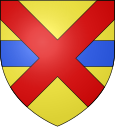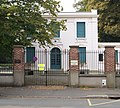Ascq
| Ascq | ||
|---|---|---|

|
|
|
| local community | Villeneuve-d'Ascq | |
| region | Hauts-de-France | |
| Department | North | |
| Arrondissement | Lille | |
| Coordinates | 50 ° 37 ′ N , 3 ° 10 ′ E | |
| Post Code | 59650 | |
| Incorporation | 1970 | |
 Rue Gaston Baratte main street and Saint-Pierre-en-Antioche church |
||
Ascq is a village in northern France on the border with Belgium . It is located in the Mélantois on the Marque a few kilometers east of Lille . Up until the industrial revolution, Ascq was a farming village; today it is part of the city of Villeneuve-d'Ascq .
The place gained tragic fame after the Ascq massacre . German soldiers of the 12th SS Panzer Division "Hitler Youth" murdered 86 residents on the night of April 1st, 1944.
Surname
The name of the place is said to be of Germanic ( Flemish ) origin and mean "ash" (Flemish ask). 1164, 1194 and 1264, Ascq occurs as an ash in documents. In a copy of the year 1200, the place is referred to as Aqua, 1460 for the first time in today's spelling.
history
In the 5th century, the area belonged to the territory of the Salfranken , later to the Asnapio crown domain . Charlemagne handed it over to his son Ludwig , as a dowry it went to his daughter Gisela and thus to her husband Eberhard von Friuli . The place was first mentioned by name in the year 867 in Eberhard's will. By marriage, Ascq came to the county of Flanders in the 12th century . In 1213 Philip II of France had the area around Lille devastated.
After the Franco-Flemish War, Ascq and the Burgraviate of Lille became part of France for 64 years in 1305 . This time was marked by incursions by French, Flemish and English troops, from which Ascq also suffered badly. The crops were looted and the village set on fire. Famines have been reported for 1316 and more years. In the Hundred Years' War Ascq was occupied militarily in 1340, nine years later raged there for the first time the plague .
Given the permanent presence of troops, farmers gave up growing wheat in the 15th century and instead cultivated woad , flax and hemp . In 1449 the place had 99 inhabitants, in 1505 650 people were counted. In 1534 and three times in the 17th century the plague broke out again. In 1609 the place came to the County of Annappes , in 1640 Forest-sur-Marque was detached from the area of Ascq. In the course of the 17th century the rulers changed several times: one after the other, Ascq belonged to the Duchy of Burgundy , to the Spanish Netherlands and, after the Peace of Aachen , to France. In 1678 there were 95 households in the village.
In the course of the War of the Spanish Succession , the English general John Churchill and his soldiers occupied the village from 1708 to 1713 . During the harsh winter of 1709, numerous residents died of hunger and cold. In 1781 the moor was drained.
A bad harvest in 1788 was followed by a long and hard winter. By the summer of 1789, the price of bread doubled. As in Lille, there was no popular uprising in Ascq in 1789, but fear of robber gangs. The news of the storming of the Bastille reached the place only three days late. During the First Coalition War , Ascq was temporarily captured by opposing troops in 1794.
The community was founded in 1793 during the French Revolution , and a provisional town hall was set up the following year. During the reign of terror , the belongings of those who had fled abroad, as well as the church's inventory, were confiscated. The harsh winter of 1794/95 led to looting and epidemics. Only in 1802 did calm return to the village. As a result of the continental barrier , sugar beet cultivation began in 1809 . After Napoleon's reign of the Hundred Days with the lost battle of Waterloo , Dutch, English and Prussian soldiers moved into Ascq from 1815 to 1818 .
In 1825 156 farmers and in 1833 250 houses were counted in the village. In the 1840s, Ascq became a National Guard base . The clay deposits led to the spread of brick construction , the building material was manufactured in local brick factories . In the course of industrialization and the development by the railroad, further companies settled in Ascq in the 19th century, especially those in the food, textile and metal industries. In 1865 the place received its train station.
The hard winter of 1870/71 claimed - in addition to those who fell in the Franco-German War - numerous other human lives. The First World War again brought many victims . From October 1914 until the liberation by the British in October 1918, Ascq was occupied by the Germans. In 1917, German soldiers stole the bells from the Saint-Pierre-en-Antioche church and brought them to the German Reich . From August to October of that year the place was bombed several times by Allied planes. On October 22, 1918, Ascq was liberated by British and Portuguese soldiers.
The period between the two world wars saw a strong increase in population. In 1939 there were almost 4,000 inhabitants. Most of them were the families of workers who were employed in the railroad and in the textile industry .
The beginning of World War II brought the presence of British troops from October 1939 to May 1940. On June 1, 1940, Ascq was occupied by the German Wehrmacht . Late in the evening of April 1, 1944, partisans of the Resistance carried out an attack on a supposed freight train , in which three cars derailed and the locomotive was slightly damaged, but no casualties were recorded. It was a troop transport of the 12th SS Panzer Division "Hitler Youth" , whose commander Walter Hauck had 86 male residents between the ages of 15 and 75 shot as reprisals . Seven members of the Resistance (all from Ascq) who carried out the attack on the train were sentenced to death and executed on June 7, 1944 in Fort de Seclin . On September 3, 1944, the place was liberated by British soldiers.
On July 13, 1947, President Vincent Auriol laid the foundation stone for the memorial for the murdered.
In 1970 the municipalities of Ascq, Annappes and Flers-lez-Lille were united to form the new town of Villeneuve-d'Ascq .
Population development
| year | 1926 | 1931 | 1936 | 1946 | 1954 | 1962 | 1968 |
| Residents | 2,981 | 3.215 | 3,282 | 3,485 | 3,605 | 3,986 | 3,999 |
traffic

On the railway line from Lille to Tournai , Ascq has had a train station since 1865, where a line to Orchies branches off. It is served by passenger trains of the French state railway SNCF and their Belgian counterparts NMBS / SNCB .
The A 23 and A 27 motorways run south of the village .
economy
- Moulins d'Ascq brewery
- Bouquet d'Or chocolate factory
Attractions
- The memorial to the victims of the Ascq massacre, inaugurated in 2005
- The church of Saint-Pierre-en-Antioche from the late 15th century, restored in 1932 and between 1948 and 1951
- The “Halle aux trains” in the station's former freight shed houses a small railway museum
Memorial to the victims of the massacre
Sports
The football team Union sportive ascquoise (US Ascq) was founded in 1929.
Personalities
- Gaston Baratte (1898–1944), textile entrepreneur and victim of the massacre - the town's main street (formerly Rue Marceau) was named after him
Web links
Individual evidence
- ↑ Quartier d'Ascq at villeneuvedascq.fr, accessed on February 2, 2019
- ↑ Mangé Eugène at Rail et Mémoire, accessed on February 4, 2019
- ↑ Ascq on cassini.fr








